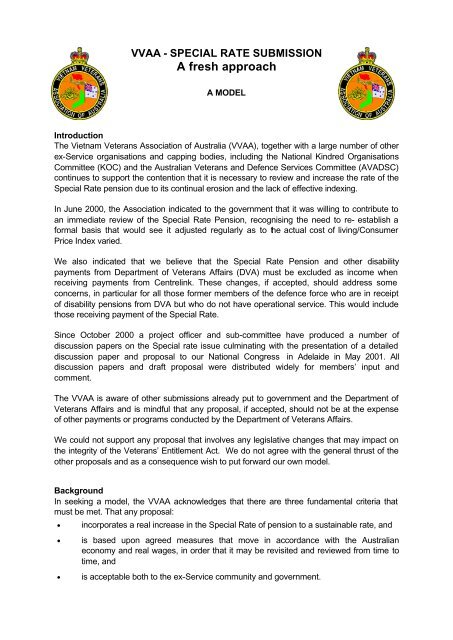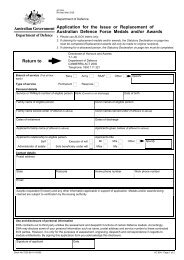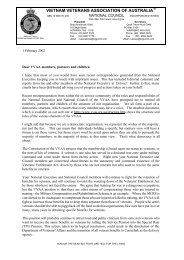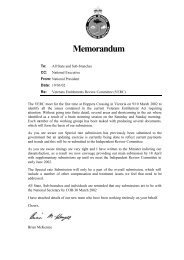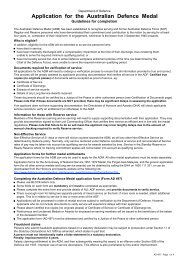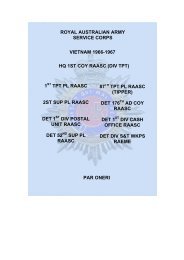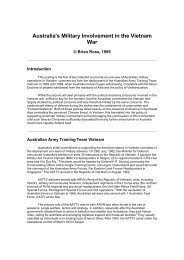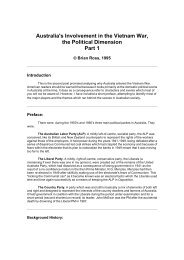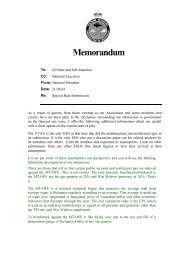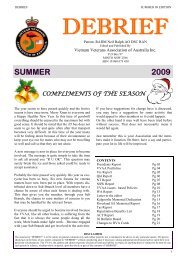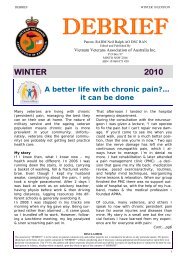viewed - Vietnam Veterans Association of Australia
viewed - Vietnam Veterans Association of Australia
viewed - Vietnam Veterans Association of Australia
You also want an ePaper? Increase the reach of your titles
YUMPU automatically turns print PDFs into web optimized ePapers that Google loves.
VVAA - SPECIAL RATE SUBMISSION<br />
A fresh approach<br />
A MODEL<br />
Introduction<br />
The <strong>Vietnam</strong> <strong>Veterans</strong> <strong>Association</strong> <strong>of</strong> <strong>Australia</strong> (VVAA), together with a large number <strong>of</strong> other<br />
ex-Service organisations and capping bodies, including the National Kindred Organisations<br />
Committee (KOC) and the <strong>Australia</strong>n <strong>Veterans</strong> and Defence Services Committee (AVADSC)<br />
continues to support the contention that it is necessary to review and increase the rate <strong>of</strong> the<br />
Special Rate pension due to its continual erosion and the lack <strong>of</strong> effective indexing.<br />
In June 2000, the <strong>Association</strong> indicated to the government that it was willing to contribute to<br />
an immediate review <strong>of</strong> the Special Rate Pension, recognising the need to re- establish a<br />
formal basis that would see it adjusted regularly as to the actual cost <strong>of</strong> living/Consumer<br />
Price Index varied.<br />
We also indicated that we believe that the Special Rate Pension and other disability<br />
payments from Department <strong>of</strong> <strong>Veterans</strong> Affairs (DVA) must be excluded as income when<br />
receiving payments from Centrelink. These changes, if accepted, should address some<br />
concerns, in particular for all those former members <strong>of</strong> the defence force who are in receipt<br />
<strong>of</strong> disability pensions from DVA but who do not have operational service. This would include<br />
those receiving payment <strong>of</strong> the Special Rate.<br />
Since October 2000 a project <strong>of</strong>ficer and sub-committee have produced a number <strong>of</strong><br />
discussion papers on the Special rate issue culminating with the presentation <strong>of</strong> a detailed<br />
discussion paper and proposal to our National Congress in Adelaide in May 2001. All<br />
discussion papers and draft proposal were distributed widely for members’ input and<br />
comment.<br />
The VVAA is aware <strong>of</strong> other submissions already put to government and the Department <strong>of</strong><br />
<strong>Veterans</strong> Affairs and is mindful that any proposal, if accepted, should not be at the expense<br />
<strong>of</strong> other payments or programs conducted by the Department <strong>of</strong> <strong>Veterans</strong> Affairs.<br />
We could not support any proposal that involves any legislative changes that may impact on<br />
the integrity <strong>of</strong> the <strong>Veterans</strong>’ Entitlement Act. We do not agree with the general thrust <strong>of</strong> the<br />
other proposals and as a consequence wish to put forward our own model.<br />
Background<br />
In seeking a model, the VVAA acknowledges that there are three fundamental criteria that<br />
must be met. That any proposal:<br />
• incorporates a real increase in the Special Rate <strong>of</strong> pension to a sustainable rate, and<br />
• is based upon agreed measures that move in accordance with the <strong>Australia</strong>n<br />
economy and real wages, in order that it may be revisited and re<strong>viewed</strong> from time to<br />
time, and<br />
• is acceptable both to the ex-Service community and government.
With this in mind we put forward a model that addresses a substantial net rise in the Special<br />
Rate pension that is based on a real monetary figure. The model is based on the Average<br />
Collective Bargain Wage 1 (ACBW) as issued by the <strong>Australia</strong>n Bureau <strong>of</strong> Statistics for the<br />
year 2001. The ACBW is a new indexing <strong>of</strong> wage movement, is a real monetary figure, is<br />
registered with the Industrial Relations Commission (IRC) and can be indexed in net terms<br />
against the MTAWE and CPI.<br />
In choosing this figure we also considered the Average Weekly Wage and the Work Place<br />
Agreement Wage. In rejecting the Average Weekly Wage like the MTAWE we note that it is<br />
a statistical figure for the year and is not a monetary value in real terms. Likewise we rejected<br />
the Workplace Agreement Wage as this figure, though a real monetary wage represents only<br />
those on incomes <strong>of</strong> $45,000 or higher per annum.<br />
In developing our model we took into consideration a number <strong>of</strong> factors and made a number<br />
<strong>of</strong> assumptions:<br />
• the Special Rate is a compensation measure initiated by government to recompense<br />
veterans under 65 years <strong>of</strong> age who because <strong>of</strong> their war or defence caused disease<br />
or injuries, cannot engage in remunerative employment and generate wealth;<br />
• each individual has a different capacity to generate wealth depending upon age,<br />
qualifications, intellect and so on – the real monetary value must cover a spectrum <strong>of</strong><br />
capacity to earn;<br />
• the real monetary figure, though re<strong>viewed</strong> every three years, is to be paid for life,<br />
whereas in the workforce individuals plan their wealth generation to be complete at<br />
age 65 or even younger;<br />
• payment <strong>of</strong> Service Pension and benefits will not change;<br />
• all TPIs would be issued with a DVA concession card;<br />
• all calculation are based on March 2001 figures;<br />
The Model<br />
The factors noted above can be used as the basis for a number <strong>of</strong> decisions upon which the<br />
model is based: (See Table 1)<br />
• The basis <strong>of</strong> the model is 60% <strong>of</strong> the ACBW. The deduction <strong>of</strong> 40% is based upon<br />
the fact that the payment is tax-free for the life <strong>of</strong> the recipient; other wage and salary<br />
earners plan to cease work at age 65; there is no requirement to contribute to<br />
Medicare or other levies; and no requirement to contribute to superannuation. This<br />
deduction equates to $284 per fortnight.<br />
• The model includes a base rate tax deduction <strong>of</strong> 17%. This is only a deduction in the<br />
model to cover the tax element that would normally be paid if the veteran worked until<br />
he/she was 65 at the full base wage. The Special Rate pension is still tax free for life.<br />
• The model can be used in calculating the General Rate and Intermediate rate within a<br />
separate formula.<br />
1<br />
Refers to Federal registered Agreement, Collective, Average Weekly Total Earnings. ABS<br />
Publication 6306.0 dated May 2000 released March 2001.
• In regard to non-economic loss we benchmarked all Special Rate recipients at 70% <strong>of</strong><br />
the General Rate <strong>of</strong> pension. This figure was chosen because it is the lowest level <strong>of</strong><br />
the General Rate at which the veteran is able to qualify for the Special Rate.<br />
• The ACBW published by the <strong>Australia</strong>n Bureau <strong>of</strong> Statistics every year, would in the<br />
model, be re<strong>viewed</strong> every three years. The Special Rate payment arrived at in the<br />
model will be subject to increase in the CPI or MTAWE whichever is the highest.<br />
Table 1 - Proposed formula to calculate Special Rate Pension<br />
Item Week Fortnight Annual<br />
Average Collective Bargain Wage - 2001 $711.00 $1,422.00 $37,073.57<br />
Rate <strong>of</strong> payment 60% 2 $853.20 $22,244.14<br />
Less non economic loss (70% General Rate) $188.08 $4,903.51<br />
Sub Total $665.12 $17,340.63<br />
Less Base taxation figure 17% 3 $73.95 $1,927.91<br />
Compensation after tax formula component $591.17 $15,412.72<br />
Add on non economic loss component $188.08 $4,903.51<br />
Special Rate Payment $779.25 $20,316.23<br />
Table 2 - Example <strong>of</strong> Proposed Married Rate with Full Service Pension and receiving<br />
Carer's allowance<br />
Item Fortnight Annual<br />
Special Rate $779.25 $20,316.23<br />
Service/equivalent pension 4 $671.00 $17,493.93<br />
Sub Total $1,450.25 $37,810.16<br />
Carer’s allowance 5 $82.00 $2,137.86<br />
Total $1,532.25 $39,948.02<br />
Table 3 - Calculation <strong>of</strong> Budget Variance - Special Rate only<br />
Item Year 1 Year 2 Year 3<br />
Number <strong>of</strong> TPIs 24,244 25,250 26,250<br />
Annual Rate 6 $20,316.23 $20,316.23 $20,316.23<br />
Annual Cost (New Rate) $493m $513m $533m<br />
Current Cost $448m $466m $485m<br />
Net Increase this year $45m $47m $48m<br />
Net Cumulative Difference $45m $92m $140m<br />
Summary<br />
The model represents an increase <strong>of</strong> $60.75 per fortnight in the Special rate. It is based<br />
upon a sustainable formula that can be recalculated when cost <strong>of</strong> living indices move. It<br />
represents an additional expenditure by government <strong>of</strong> approximately $140m over three<br />
years.<br />
This submission and model is <strong>of</strong>fered to the government and ex-service organisations for<br />
discussion as a preferred model, and notified to the Minister <strong>of</strong> <strong>Veterans</strong> Affairs as a means<br />
<strong>of</strong> resolving the current impasse.<br />
2 Variable if level <strong>of</strong> erosion is identified<br />
3 Calculated on $17,340.63 less the tax threshold <strong>of</strong> $6000.00 or $11,340.63<br />
4 Approx 50% on Special rate are in receipt <strong>of</strong> full service pension, 25% part service pension and 25% no service<br />
pension<br />
5 Centrelink criteria must be met - currently less than 15% are in receipt <strong>of</strong> this payment<br />
6 No allowance has been made for any adjustments <strong>of</strong> this rate after March 2001 figures
Recommendations<br />
The VVAA recommends that; in the absence <strong>of</strong> any organised review <strong>of</strong> Special Rate<br />
payment that a joint working party be established with representatives from Ex-service<br />
Organisations and the Department <strong>of</strong> <strong>Veterans</strong> Affairs.<br />
This group should establish a 'Terms <strong>of</strong> Reference' to determine an agreed level <strong>of</strong> erosion<br />
<strong>of</strong> Special Rate payments, and to identify an effective model whereby the payment can be<br />
revisited and re<strong>viewed</strong> from time to time ensuring that living standards <strong>of</strong> the recipients are<br />
maintained.<br />
Distribution<br />
Copies <strong>of</strong> this Submission have been sent to:<br />
• Minister Of <strong>Veterans</strong> Affairs, Hon Bruce Scott MP;<br />
• Shadow Minister <strong>of</strong> <strong>Veterans</strong> Affairs, Senator Chris Schacht MP;<br />
• <strong>Australia</strong>n Democrats spokesperson on veterans issues, Senator Andrew Bartlett;<br />
• Member for Cowan and <strong>Vietnam</strong> Veteran, Hon Graham Edwards MP;<br />
• Secretary, Department <strong>of</strong> <strong>Veterans</strong> Affairs, Dr Neil Johnston;<br />
• National President, Returned and Services League <strong>of</strong> <strong>Australia</strong>, MAJGEN Peter<br />
Phillips; and<br />
• Federal President, <strong>Australia</strong>n Federation <strong>of</strong> T&PI Servicemen and Women, Mr John<br />
Ryan.<br />
Acknowledgement<br />
This document is the VVAA's contribution to the current debate on the erosion <strong>of</strong> the Special<br />
Rate payment. The VVAA National Council wishes to thank the members <strong>of</strong> the <strong>Association</strong><br />
for their constructive input and significant contribution to this model over the last 12 months.<br />
It has been a team effort


